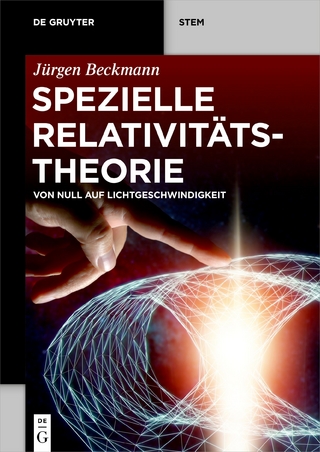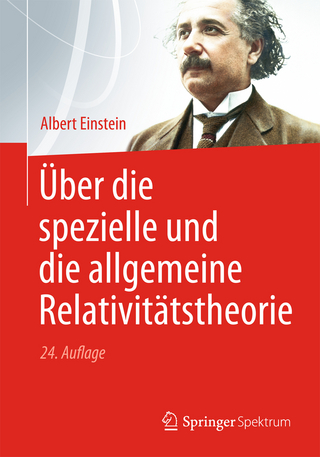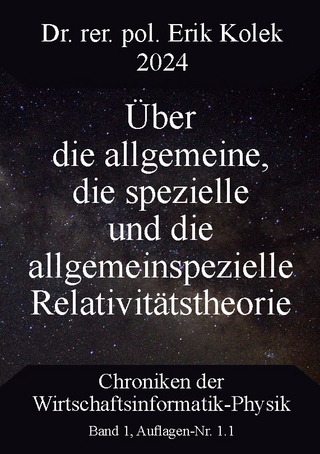
Understanding Relativity
Birkhauser Boston Inc (Verlag)
978-0-8176-3150-5 (ISBN)
- Titel ist leider vergriffen;
keine Neuauflage - Artikel merken
There are exterminators and there are scientific exterminators. We all know how the modifier "scientific" inttudes in our daily life. It is the purpose of this book to challenge the belief that scientific knowledge is different from other kinds of knowledge.
I. The Creation of The Theory of Relativityl.- 1.Science, Logic, and Objectivity.- The Role of Mathematics and Other Formal Systems in Science.- The Case of Euclidean Geometry.- The Case of Natural Numbers.- The Case of Free Fall.- The Aristotelian Analysis of Motion.- The Galilean Analysis of Free Fall.- Belief as a Cultural Phenomenon.- Objectivity and the Social Institutions of Science.- Science and Technology.- 2. The Rise and Fall of the Mechanical World View.- The Seventeenth Century.- The Evidence.- Newton's Axioms and Definitions.- The Application and Consequences of Newton's Laws.- Newton's Theory of Measurement.- The Galilean Transformation Equations.- The Classical Principle of Relativity.- The Search for the Absolute Frame of Reference.- 3. Einstein's Special Theory of Relativity and Its Consequences.- The Special Theory of Relativity.- The Postulates.- Simultaneity.- The Relativity of Simultaneity.- The Order of Events and Causality.- The Relationship of Einstein's Theory to Lorentz's Theory.- Time Dilation and the Relativity of Simultaneity.- Length Contraction.- Mass.- 4. Further Consequences of the Heuristic Nature of the Special Theory of Relativity.- Mass and Energy.- The Clock Paradox.- Four-Dimensional Analysis.- 5. The General Theory of Relativity.- II. The Early Response to the Special Theory of Relativity, 1905-1911.- 6. When a Hundred Flowers Bloom: The German Response.- The Contributions of Max Planck.- The Rigidity Paradoxes.- Wave and Group Velocity.- 7. As If It Never Happened: The French Response.- Henri Poincare.- The Principle of Relativity.- Poincare and Second Order Theory.- The Theory of Electrons.- Poincare's Vision of a Good Theory.- Simplicity and Induction.- Flexibility and Gradualism.- Naturalness and the Increase of Hypotheses.- Poincare's Silence and Einstein's Theory.- Other French Response.- Aftermath.- 8. Defending the Ether: The British Response.- The Tradition of British Ether Theory.- Oliver Lodge.- The Mechanical Ether.- The Introduction of Relativity Theory.- Conclusions.- 9. Defending the Practical: The American Response.- The American Tradition in Science.- Science and American Technology.- Science and American Universities.- The American Physics Community.- American Silence, 1905 -1907.- The Contributions of Lewis and Tolman.- Reaction to Lewis and Tolman.- The Appeal to Common Sense.- The Popular Response, 1905-1911.- Conclusions.- III. From Response to Assimilation.- 10. Relativity in America, 1912-1980.- 1911-1919: The Lull Before the Storm.- The Assimilation of Special Relativity Within the Scientific Community, 1920-1980.- The Evidence.- Graduate Textbooks, 1920-1945.- Advanced Undergraduate Textbooks, 1920-1945.- Introductory Textbooks, 1920-1945.- Post World War II.- Bridgman's Operationism and Einstein's Relativity.- Bridgman's Early Studies of Relativity Theory.- Being Operational Versus Operationism.- Spreading Time Through Space, 1959-1961.- Philosophy and Physics.- The Popular Response to the Theory of Relativity.- Conclusions.- 11. Relativity and Revolutions in Science.- Scientific Revolutions.- Relativity and Scientific Revolutions.- Appendix 1. Trigonometry.- Appendix 2. Kinematics: The Galilean Description of Motion.- Appendix 3. Newtonian Mechanics.- Appendix 4. The Kinetic Theory of Matter and the Mechanical World View.- Appendix 5. Ether Drift Experiments: The Search for Absolute Frame of Reference.- Appendix 6. Some Relativistic Derivations.- Bibliographic Essay: On Understanding Relativity.- Inde.
| Erscheint lt. Verlag | 1.1.1984 |
|---|---|
| Zusatzinfo | 26 black & white illustrations, biography |
| Verlagsort | Secaucus |
| Sprache | englisch |
| Gewicht | 995 g |
| Themenwelt | Naturwissenschaften ► Physik / Astronomie ► Relativitätstheorie |
| ISBN-10 | 0-8176-3150-X / 081763150X |
| ISBN-13 | 978-0-8176-3150-5 / 9780817631505 |
| Zustand | Neuware |
| Informationen gemäß Produktsicherheitsverordnung (GPSR) | |
| Haben Sie eine Frage zum Produkt? |
aus dem Bereich


